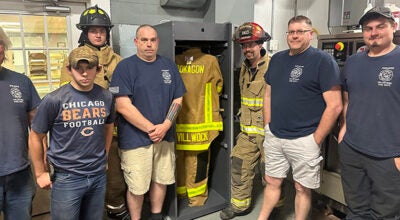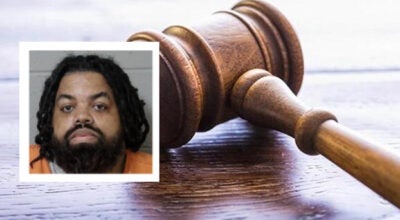Principal stokes science interest
Published 11:55 pm Tuesday, September 13, 2011
Fifteen Dowagiac Middle School seventh graders followed a satellite Tuesday morning, writing a new chapter in a mission that began two years ago in fifth grade at Sister Lakes Elementary School, where Matt Severin was then principal. While Lea Cooper aimed the antenna and McKenzie Hassle held the tablet tracking the path across the sky, Vivianna Lucio, James Tovey, Alexis Chorba, Drake Henslee, William Revis, Antonio Brito, Roel Rios, Angelica Hernandez, Jessaney Stockwell, Collin Hassle, Valerie Valenzuela and Arden Reiter tabulated data, including the secret word, eagles. Morgan Beach, the third girl wearing an orange shirt, was the timer. ARISSat-1 is an amateur radio satellite hand-launched from the International Space Station during an EVA (Extra Vehicular Activity). They were able to capture two full images during Tuesday morning’s pass. (The Daily News/John Eby)
Dowagiac Middle School Principal Matt Severin doesn’t care if his students share his enthusiasm for tracking ARISSat-1, an amateur radio satellite hand-launched from the International Space Station.
What he does care about is that they find something about which they are passionate.
Still, being able to tell seventh graders, “You’re up there flying around the earth at 17,000 mph” is a pretty good hook when you’re promoting interest in STEM — science, technology, engineering and math.
Another pertinent acronym is MET, or Mission Elapsed Time.
The photo of the 15 DMS students gathered outside the school at 11:07 a.m. Sept. 13 and now a fly-a-file aboard the satellite was taken two years ago when they were fifth graders at Sister Lakes Elementary School when he was principal there.
“You were looking at a computer, watching a weather satellite” after Hurricane Ida, Severin reminds them.
“Right now, all of you are flying around the earth on a satellite. This satellite sends down a bunch of different information. It’s taking pictures of the earth, and we’ll see if we can’t capture some of those. It’s sending down telemetry — how hot it is, how much energy in the battery, the current and the voltage, things like that. Some of you are going to be in charge of writing down when the picture comes, some of you are going to be in charge of writing down the telemetry (relayed in a robotic voice). Two will be pointing the antenna in the right direction. We’ll record it all and I’ll run it through my computer at home and print pictures off so you guys can see what we got today. Once all of this is done, I can send off all of the information and they’ll send us a ‘Certificate of Reception.’
The satellite is “a little box,” explained Severin, whose own dream is to visit the vastness of space.
A shorter-term goal is to connect his students with the International Space Station for a little Q&A.
“I think it’s about 2×2 by one foot. It goes around the earth every 90 minutes, roughly, and is over us for 10 minutes. This satellite has had all kinds of problems. The batteries are dying, so every time it goes into shadow it goes off. The neat thing for me is it has radio equipment on it. I don’t have the right equipment here, but I can talk to hams across the U.S. through the satellite.”
Voices Dowagiac students hear are “recordings of students involved with it, like we sent our file in, somehow they had that opportunity. We heard Spanish, two children from England. The next level we could take this to in the classroom is that telemetry and graphing it, so you can see that the temperature goes up and down depending on whether it’s in sunlight or shadow. Solar panels, you can see the charge go up and down. Because the satellite spins, you see a change in the charge or the current in the solar panel. If it’s facing the sun, it’s going to have a high current. Facing away, it’s almost zero.”
At home, Severin “collects telemetry all the time. My computer is set up to record it. It’s trying to make it more hands-on and real-life.”
Besides the arrow antenna, he also has one made from tape measures.
“It’s my dream someday to go to outer space,” Severin told students. “I get a little closer sending stuff to a satellite, even though I’m not there yet.”






